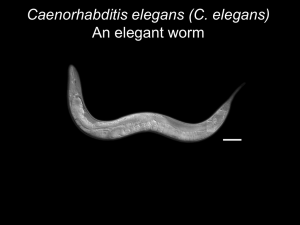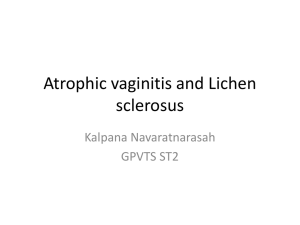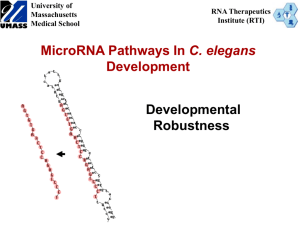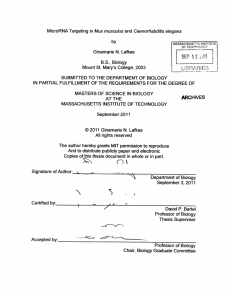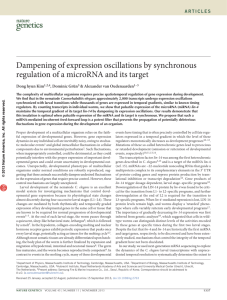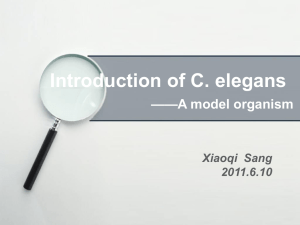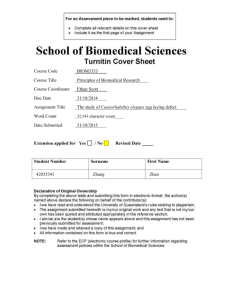C. elegans
advertisement
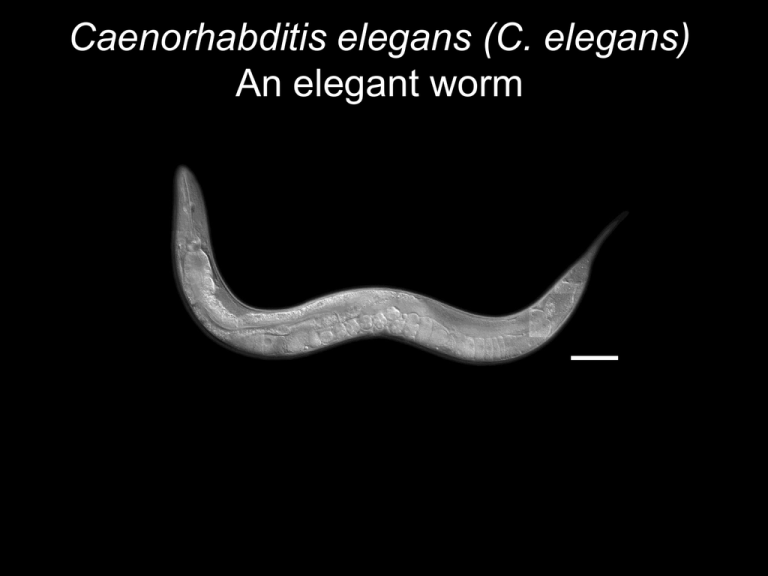
Caenorhabditis elegans (C. elegans) An elegant worm Why study worms? Sydney Brenner “Thus we want a multicellular organism which has a short life cycle, can be easily cultivated, and is small enough to be handled in large numbers, like a micro-organism. It should have relatively few cells, so that exhaustive studies of lineage and patterns can be made, and should be amenable to genetic analysis.” --Excerpts from Proposal to the Medical Research Council, 1963 C. elegans: the chosen one! Easily cultivated: can grow thousands on a petri dish, feed on non-hazardous bacteria, and cheap to maintain Short generation time: 3 days Small: 1 mm (about the size of a pinhead) Few cells: The adult has 959 hermaphrodrodite (XX) or 1031 (XO) cells Amenable to genetic analysis: maintained as hermaphrodites, but males exist for genetic studies, The genome is small- 100 Mb Transparency: allows for development to be analyzed from a single cell and all cells to be lineage Photo credit: Ian D. Chin-Sang (Queen's University, Kingston, ON, Canada). Life cycle of C. elegans Photo credit: http://www.scq.ubc.ca/genetic-studies-of-aging-and-longevity-in-model-organisms/ Anatomy of C. elegans Pharynx head anterior Intestine (yellow) Gonad (pink) Vulva ~1 mm Fig. 5.42 Anus Rectum Epidermis tail posterior Hermaphrodites do it by themselves Hermaphrodite (XX) Males (X0) Photo credit: http://homepages.ucalgary.ca/~dhansen/worms.gif The C. elegans gonad: an extremely efficient reproductive system Fig. 5.42 Within this lineage is the secret of embryonic development John Sulston All neural synapses have been mapped An entire C. elegans hermaphrodite worm consists of exactly 959 cells EVERY SINGLE TIME, allowing one to follow the cell lineage. Learn to read a lineage diagram! Branching = cell division Increasing age of worm embryo 1st stage larva Line ending = differentiated cell 2nd stage larva = Cell death P0 zygote Cleavage Events Lineage Fig. 5.42 2 cell stage 4 cell stage 8 cell stage Most lineages consist of multiple tissue types but the P4, E and D cells gives rise to a single tissue type Fig. 5.42 Mutations can alter lineages in many ways Question: 1.) How many cell divisions took place in the wildtype lineage? ____ 2.) In wild-type, how many total descendants will cell A have? ____ 3.) How many differentiated cells from the wild-type lineage will be a part of the adult worm? ____ 4.) What is the best description of the defect in mutant 1? How are the invariant lineages established? ie. How do cells know who they are and what they are doing? • Control of apoptosis •Partitioning of cytoplasmic determinants •Timing of developmental events •Cell-Cell interactions Even cell death is programmed into the lineage C. elegans was used to identify the machinery that regulates programmed cell death in vertebrates See also p. 96 for further discussion of cell death pathways The Nobel Prize in Physiology or Medicine 2002 "for their discoveries concerning ’ genetic regulation of organ development and programmed cell death'" Sidney Brenner H. Robert Horvitz John Sulston Partitioning of cytoplasmic determinants blue nuclei P-granules (green) are cytoplasmic determinants that are formed from ribonucleoprotein complexes that specify the germ cells P granules are asymmetrically segregated into one cell, the P4 cell, which will give rise to the germline Fig. 5.44 P0 P1 AB P3 P4 green P-granules PARtition mutants (PAR) disrupt the asymmetric distribution of p-granlues Photo credit: http://mbg.cornell.edu/cals/mbg/research/kemphues-lab/images/par_phenotypes.gif Timing of developmental events Lof= loss of function, gene function is disrupted wildtype lin-14 (lof) lin-4 (lof) Moss E. 2007. Current Biology, R425. Lin-14 is required for the timing of cell division in the L1 stage. Lin-4 regulates transition from L1 to L2 stage. wildtype lin-14 (lof) lin-4 (lof) Graph of LIN-14 and LIN-4 levels in a wildtype embryo Levels LIN-4 L1 L2 L3 L4 LIN-14 Adult Time If you have a mutation that results in an INCREASED level of LIN-14 (gain of function) which lineage would you expect wildtype lin-14 (lof) lin-4 (lof) Graph of LIN-14 and LIN-4 levels in a wildtype embryo Levels LIN-4 L1 L2 L3 L4 LIN-14 Adult Time lin-4 does not encode a protein— It encodes a microRNA !! lin-4 lin-4 lin-14 lin-4 lin-14 Translation blocked! Cell-Cell Interactions: the P2 impact! GLP-1 APX-1 Notch receptor Delta-like ligand MOM-2 Wnt homolog MOM-5 Frizzled homolog Signal from P2 cell required to induce EMS cell to produce E cell which forms the gut (see p. 198-199) How do cell interactions result in the formation of an organ? Vulva formation! C. elegans Vulva development Early larval stage Anchor cell (AC) Figure 3.34 Gonad VPCs AC Basement membrane Gonad P3.p-P8.p are the Vulva Precursor Cells (VPCs) Later larval stage 1° and 2° VPCs make the vulva 3° VPCs are non-vulval 3° 2° 1° 2° 3° Inductive and lateral signals induce the vulva gonad Anchor cell VPCs VPCs after induction P8 3° 3° 2° 1° 2° 3° The primary and secondary cells form the vulva Cell ablation studies helped identify key players in vulva formation Lecture notes: experiment 1 If anchor cell signaling is disrupted, all VPCs cells adopt a non-vulva fate anchor cell gonad 3° cell 3° cell 3° cell 3° cell no vulva 3° cell 3° cell The VPCs have multipotential Early stage Anchor cell gonad VPCs Later stage Anchor cell gonad 3° 3° 2° 1° 2° 3° What is causing the VPCs to be different? Let’s do an experiment: what happens when the P6.p cell is ablated? Anchor cell gonad VPCs 3° 3° 2° 3° 2° 3° 3° 2° 2° 3° 3° 3° 3° 3° 3° 3° 2° 1° 2° 1° A B C Lecture notes: experiment 2 3° What genes specify the VPC cell fate? Looked for mutants that disrupted vulva formation 1) No vulva: worms hatch inside (yuck!!) 1) Too many vulvas Lecture notes: experiment 3 Inductive and lateral signals induce the vulva gonad Anchor cell VPCs VPCs after induction P8 3° 3° 2° 1° 2° 3° The primary and secondary cells form the vulva The vulvaless mutations helped define the Ras pathway Lin-3/Epidermal Growth Factor (EGF) Let-23/EGF Receptor Let-60/RAS Sem-5/GRB2 Lin-45/RAF P6.p becomes the primary cell! The Ras pathway is abnormally activated in many human tumors eg: pancreatic cancer, colorectal cancer, lung adenocarcinoma, gall bladder cancer, bile duct cancer and thyroid cancer Another representation of the RAS pathway (VPC cells) LIN-3 signal A signal from P6.p actives notch (lin-12) in P5.p and P7.p Figure 3.34 The transmembrane receptor is the Lin-12 protein, a receptor protein related to Notch “ Primary cell” “ Secondary cells” Figure 3.33 Both membrane and receptor are membrane bound! Generation of Different Cell Types From Equivalent Cells in C. elegans: Initial specification of the Anchor Cell also requires Notch The signal: lag-2 (delta) Figure 3.35 The receptor: lin-12 (notch) Does the Notch pathway remind you of anything you learned earlier? No notch=neural! The story of epidermal vs. neuronal fate in Drosophila Some cells become neuroblasts and signal their neighbors to remain epidermis If signal is missing... all cells eventually ingress and become neuroblasts Nervous system Epidermis Extra nervous system No epidermis!
